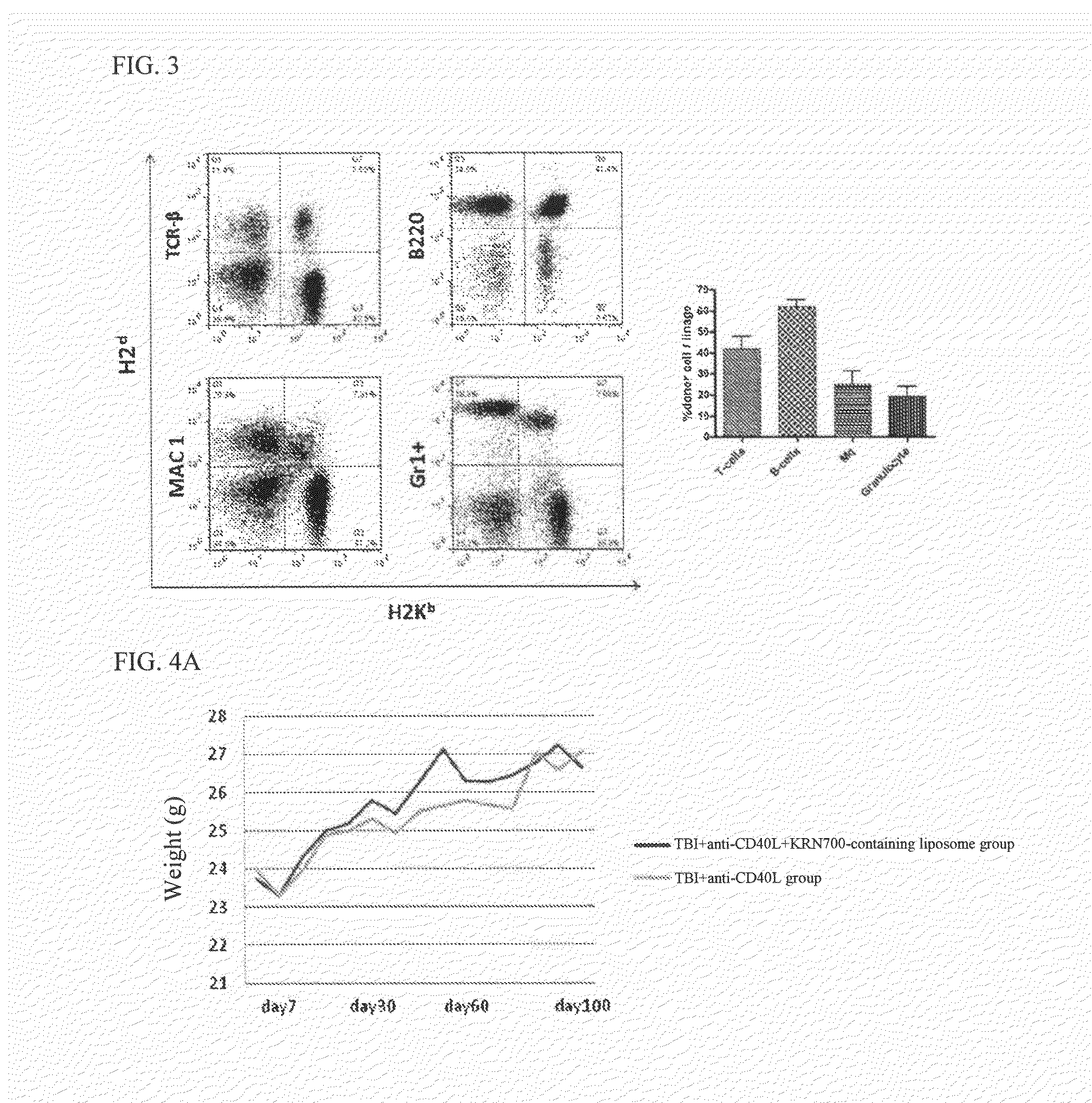Immune-tolerance inducer
a technology of immune tolerance and inducer, which is applied in the direction of antibody medical ingredients, drug compositions, immunological disorders, etc., can solve the problems of difficult application of this pretreatment to all organ failure patients, unproven safe and reliable methods, and inability to say that the long-term survival rate of the transplanted organ is good, etc., to achieve effective induced immune tolerance in the recipient, stably maintained, and inducible immune tolerance in the transplanted immunity
- Summary
- Abstract
- Description
- Claims
- Application Information
AI Technical Summary
Benefits of technology
Problems solved by technology
Method used
Image
Examples
example 1
Bone Marrow Transplantation and Preparation of Bone Marrow Chimera
[0091]Male mice C57BL / 6NCrSlc (B6, H-2b), BALB / cCrSlc (BALB / c, H-2d), and C3H / HeSlc (C3H, H-2k) of 8 to 12 weeks old were purchased from Japan Slc, Inc. The mice were bred in accordance with animal management guidelines of NIH, under an SPF environment of Institute of Laboratory Animals, Tokyo Women's Medical College.
[0092]The recipient BALB / c mouse was irradiated with TBI (total body irradiation) 3Gy (X-ray generator (MBR-1520R-3, Hitachi medical Corp., Tokyo, Japan) 2 to 3 hours before bone marrow transplantation. Subsequently, an anti-CD40L antibody was diluted with PBS (Invitrogen, Grand Island, N.Y., USA), and 0.5 mg of the anti-CD40L antibody was intraperitoneally administered immediately after bone marrow transplantation. The anti-CD40L antibody was purchased from Bixcell (West Lebanon, N.H., USA). Further, KRN7000-containing liposome (containing 10% of KRN7000 expressed in terms of the lipid amount) obtained b...
example 2
[0102]Ectopic heart transplantation was performed from the same donor (B6 mouse) as the bone marrow donor 14 days after bone marrow transplantation of the TBI+anti-CD40L+KRN7000-containing liposome group and TBI+anti-CD40L group in Example 1. Both donor and recipient mice were anesthetized by intraperitoneally administering Pentobarbital (Dainippon Sumitomo Pharma, Osaka, Japan). The donor mouse was cut opened its abdomen, and 1% heparin physiological saline was injected from the abdominal aorta to perfuse the blood, then the mouse underwent thoracotomy, and the heart was excised. The recipient mouse was cut opened its abdomen, and the ascending aorta and the pulmonary artery of the donor heart were respectively end-to-side anastomosed to the abdominal aorta and the vena cava with 10-0 nylon thread. After the operation, the pulsation of the transplanted heart in the abdomen was manually confirmed, and when the pulsation could not be confirmed, the mouse was cut ...
example 3
Evaluation of Cytokine Production and Regulatory T Cells after Bone Marrow Transplantation
[0106]Serum cytokine (IL-2, IL-4, IL-10, IL-12, and IFN-γ) values were measured 2, 24, and 48 hours after bone marrow transplantation for each group in Example 1. The results are shown in FIGS. 8 to 12.
[0107]IL-10 slightly increased 2 hours after transplantation in the TBI+anti-CD40L group, but was much lower as compared to those in the TBI+anti-CD40L+KRN7000-containing liposome group and the TBI+KRN7000-containing liposome group. However, these cytokines were withdrawn 24 hours after transplantation. IL-12 also rapidly increased after transplantation in the TBI+anti-CD40L+KRN7000-containing liposome group and the TBI+KRN7000-containing liposome group. While IL-12 production was enhanced after 24 hours in the TBI+KRN7000-containing liposome group, IL-12 was withdrawn after 24 hours in the TBI+anti-CD40L+KRN7000-containing liposome group. In the TBI+KRN7000-containing liposome group, following t...
PUM
 Login to View More
Login to View More Abstract
Description
Claims
Application Information
 Login to View More
Login to View More - R&D
- Intellectual Property
- Life Sciences
- Materials
- Tech Scout
- Unparalleled Data Quality
- Higher Quality Content
- 60% Fewer Hallucinations
Browse by: Latest US Patents, China's latest patents, Technical Efficacy Thesaurus, Application Domain, Technology Topic, Popular Technical Reports.
© 2025 PatSnap. All rights reserved.Legal|Privacy policy|Modern Slavery Act Transparency Statement|Sitemap|About US| Contact US: help@patsnap.com



